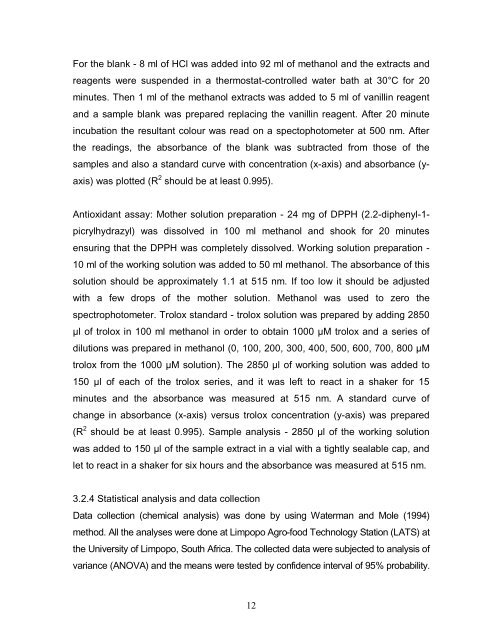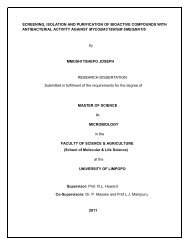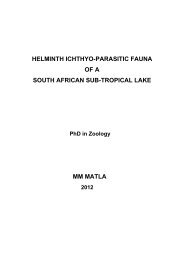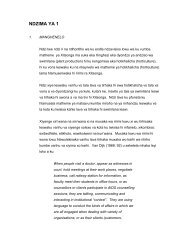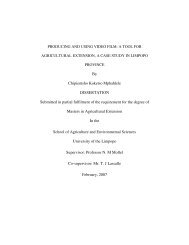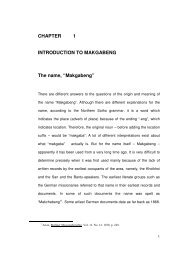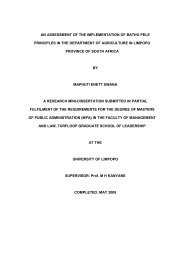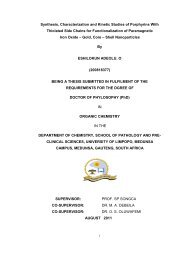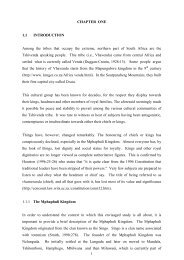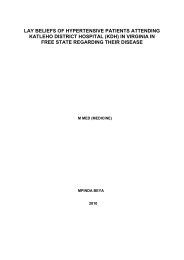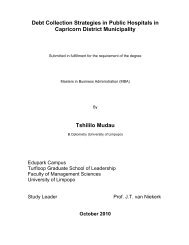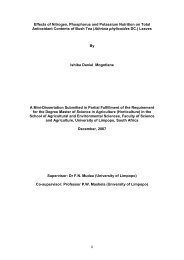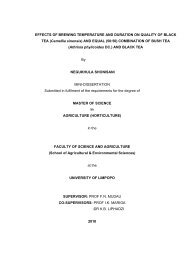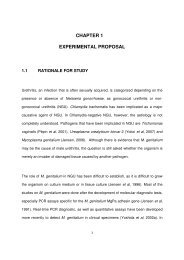Hlahla LN Mini-Dissertation.pdf - University of Limpopo Institutional ...
Hlahla LN Mini-Dissertation.pdf - University of Limpopo Institutional ...
Hlahla LN Mini-Dissertation.pdf - University of Limpopo Institutional ...
You also want an ePaper? Increase the reach of your titles
YUMPU automatically turns print PDFs into web optimized ePapers that Google loves.
For the blank - 8 ml <strong>of</strong> HCl was added into 92 ml <strong>of</strong> methanol and the extracts and<br />
reagents were suspended in a thermostat-controlled water bath at 30°C for 20<br />
minutes. Then 1 ml <strong>of</strong> the methanol extracts was added to 5 ml <strong>of</strong> vanillin reagent<br />
and a sample blank was prepared replacing the vanillin reagent. After 20 minute<br />
incubation the resultant colour was read on a spectophotometer at 500 nm. After<br />
the readings, the absorbance <strong>of</strong> the blank was subtracted from those <strong>of</strong> the<br />
samples and also a standard curve with concentration (x-axis) and absorbance (y-<br />
axis) was plotted (R 2 should be at least 0.995).<br />
Antioxidant assay: Mother solution preparation - 24 mg <strong>of</strong> DPPH (2.2-diphenyl-1-<br />
picrylhydrazyl) was dissolved in 100 ml methanol and shook for 20 minutes<br />
ensuring that the DPPH was completely dissolved. Working solution preparation -<br />
10 ml <strong>of</strong> the working solution was added to 50 ml methanol. The absorbance <strong>of</strong> this<br />
solution should be approximately 1.1 at 515 nm. If too low it should be adjusted<br />
with a few drops <strong>of</strong> the mother solution. Methanol was used to zero the<br />
spectrophotometer. Trolox standard - trolox solution was prepared by adding 2850<br />
µl <strong>of</strong> trolox in 100 ml methanol in order to obtain 1000 µM trolox and a series <strong>of</strong><br />
dilutions was prepared in methanol (0, 100, 200, 300, 400, 500, 600, 700, 800 µM<br />
trolox from the 1000 µM solution). The 2850 µl <strong>of</strong> working solution was added to<br />
150 µl <strong>of</strong> each <strong>of</strong> the trolox series, and it was left to react in a shaker for 15<br />
minutes and the absorbance was measured at 515 nm. A standard curve <strong>of</strong><br />
change in absorbance (x-axis) versus trolox concentration (y-axis) was prepared<br />
(R 2 should be at least 0.995). Sample analysis - 2850 µl <strong>of</strong> the working solution<br />
was added to 150 µl <strong>of</strong> the sample extract in a vial with a tightly sealable cap, and<br />
let to react in a shaker for six hours and the absorbance was measured at 515 nm.<br />
3.2.4 Statistical analysis and data collection<br />
Data collection (chemical analysis) was done by using Waterman and Mole (1994)<br />
method. All the analyses were done at <strong>Limpopo</strong> Agro-food Technology Station (LATS) at<br />
the <strong>University</strong> <strong>of</strong> <strong>Limpopo</strong>, South Africa. The collected data were subjected to analysis <strong>of</strong><br />
variance (ANOVA) and the means were tested by confidence interval <strong>of</strong> 95% probability.<br />
12


